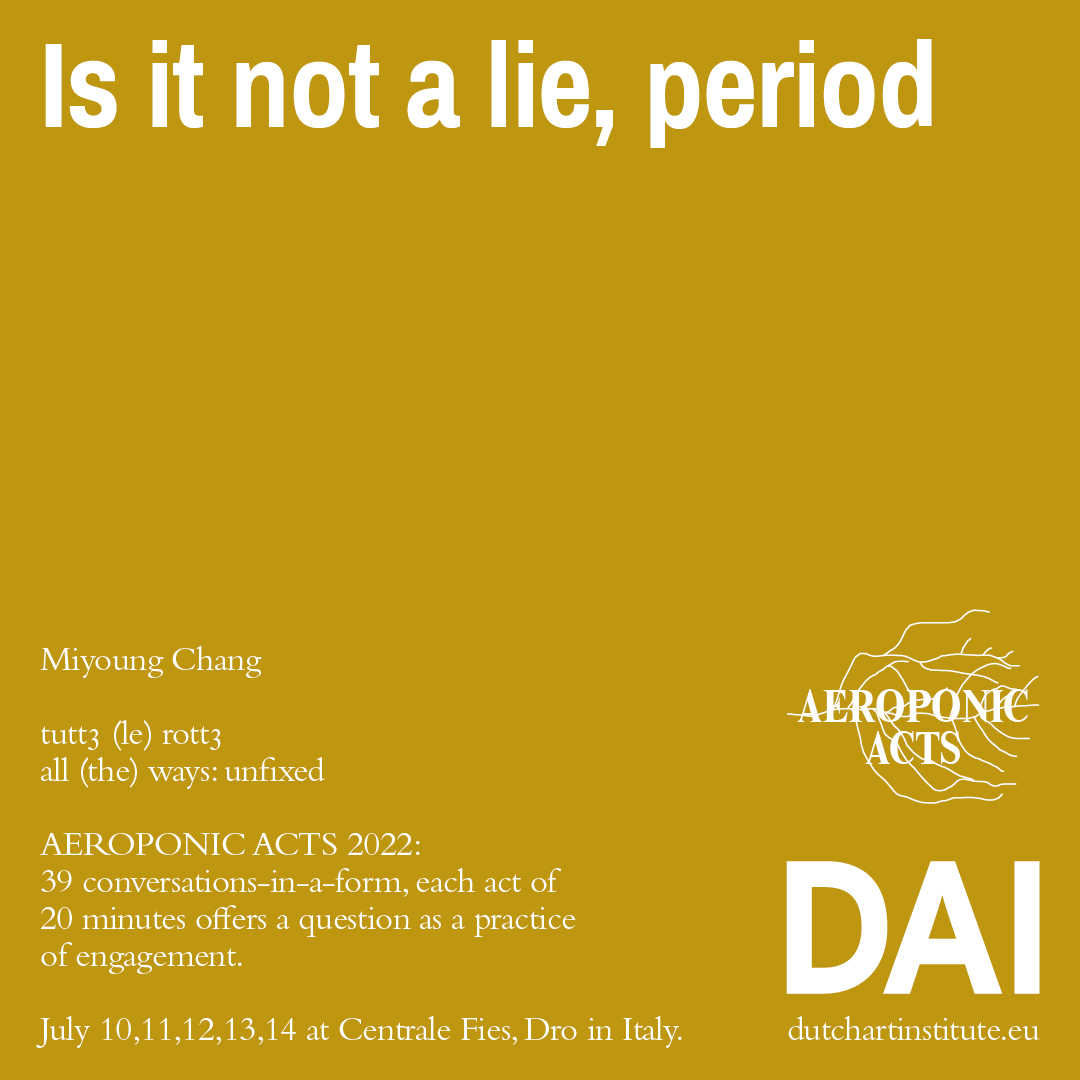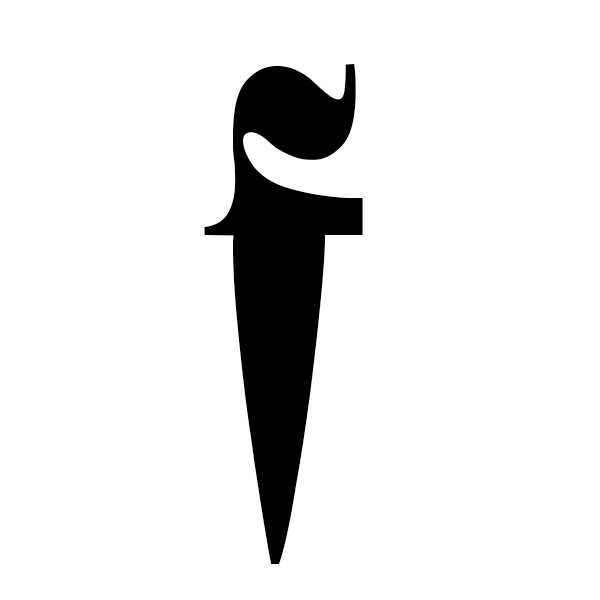Miyoung Chang: No, not.
‘Aeroponic’ – root systems nourished by air – Acts is the name given to the nomadic Dutch Art Institute’s final Kitchen presentations. Each participant addresses one question, as a practice of engagement.
Here you will find the documentation of Miyoung Chang's presentation as filmed by Baha Görkem Yalım. The written report is by Hubert Gromny and it includes a summary of the comments by esteemed guest respondents.
No, not.
Miyoung's question: Is it not a lie, period
Miyoung's introduction: All the I(s) that appear on the eyes are those who have come before the child has arrived—in the language system she uses most often, the pronunciation of the word child 아이 is identical to the pronunciation of the English word "I," I do not wish to explain, yet, I cannot help it.
For the "I" who cannot speak the I have spoken of you, no, for the "you" who cannot speak of you have spoken of the I, and yes, two pairs of hands wear an additional layer on top of their bruised skin; two pairs of arms dismiss each other heavy weighted; two pairs of knees fracture into double their amount, for the you have turned off the light the I shall take a sip from a half-emptied glass, not, a pause, and thus, a person confesses. Speak. (...) once wrote a book where the protagonist is the I, no, me, no, her, a scoff, shut up.
For the "written I" can only prove the absence of what it wishes to confirm, she (she is a fake, it is not a lie) makes the book become one silken tofu, or, a faded paperweight, or an improvised weapon in a horror film, and yes, although the tongue does not have a spine, it papercuts the eye and hence.
Two persons face each other. The table is for four.
Not.
Hubert's report: The audience enters a bright room. Miyoung and Dakota Guo are sitting back to back in the middle of the space. They are dressed in black and white. In front of Miyoung there is a small lamp, while Dakota is facing a glass of water. Delicate installation made of sewing strands organize the space stretching across the room, small wooden platforms are distributed on each side of the strand. On top of them there are various objects: metal pins, glasses, gloves, lacy textiles, a knife, metal chopsticks and a piece of broken ashtray. Two piles of publication with text and low resolution images are lying on the floor. On the side of the room the microphone is located and Marika Vanderkrats begins to read the text. Miyoung and Dakota remain unmoved. With the pause in the reading Miyoung turns on the lamp, while Dacota slightly change position of sitting. A ticking sound and jingles come out the speakers. Dakota overturns the glass of water and leans forward while Miyoung leans backwards accordingly. Their backs do not touch each other but the coordinated movement gives a feeling as if they were supporting each other. They remain still until the sound of ticking and jingles comes back. With the sound resembling a synthetic bird chirping they lace their legs together. The source of the sound is a small mechanical puppy held by Nash Caldera sitting with the rest of the audience. The sound becomes louder and Dakota and Miyoung change position again. They place their bodies as if preparing for the sprint. Rhode Vissers reads a final part of the text. Dakota and Miyoung remain unmoved. Relaxing their bodies and standing up marks the end of the performance.
Ana Teixeira Pinto commented that the work operates with very symbolic grammar difficult to decode. Ana reflected on a disconnected form of the piece and connected it to the concept of the concept of the human body as a medium—a transmitter that channels and captures electromagnetic waves. In the 19th century such an idea was very present along with a belief that these waves were messages transmitted from outer space and another world. The presence of the lamp and its connection to electricity were hints for this reading of the piece. Another evocative reading of the work proposed by Ana dealt with representation of transmodification and becoming—the processes of fictionalization of metamorphosis and their rendering as monstrous within the formation of modernity.
Phanuel Antwi analyzed the title as an entry point to understand the complicated grammar of the piece. The texts in the title, built on double negation, point towards an improper use of English. Another rule-breaking gesture is the use of punctuation. Comma and period suggest the pause, a space of the rest and a space where one can catch the breath. These four elements double negation and double punctuation allows entering the work from the grammatical viewpoint of the text. Even though the Standard English requires to fix only one negative form for each subject, many native forms of speech have double negatives. Phanuel referred to his work with Jamaican English (in dub poetry) in which double negative is an emphasis of negation, and commented further on the text accompanying the piece in which Miyoung speaks of Korean grammar and especially the sonic ambiguation—the sound transcribed in English as “I” in Korean stands for a word “child”. The piece operated on multiple grammar structures, beginning with the pause, doubling the negation and finishing with the pause it translated a grammatical riddle of the title into a spatial performance.
Chiara Figone drew attention to the sewing threads. Threads are usually used for binding, in the performance the thread was at the same time means of defying identities, while simultaneously binding connection to all present in the room. As such, using the thread was an interesting gesture of creating a certain form of domesticity. Chiara noticed that the work left many clues for the audience to put them together and decipher without really pointing out what signification they carry for the performers. The work was operating on the level of details—how metal pins were piercing the material, how threads were connected and bound, how textile material was interrupted—which coupled with the specific form of writing, was both alluding to connectivity and refusing to follow threads. The symbolic weaving of clues and fragments gave a sense of inhabiting the space actively. Chiara noticed that even though work was not easy to read it carried an idea of multiple versions of selves and interrogated how these versions define the space through language.
Miyoung Chang's "No, not." was presented before live audience at the Centrale Fies, Dro, Italy on July 13th.
Find the overview of all 24 AEROPONIC ACTS 2022 here: tuttə (le) rottə - all (the) ways: unfixed


